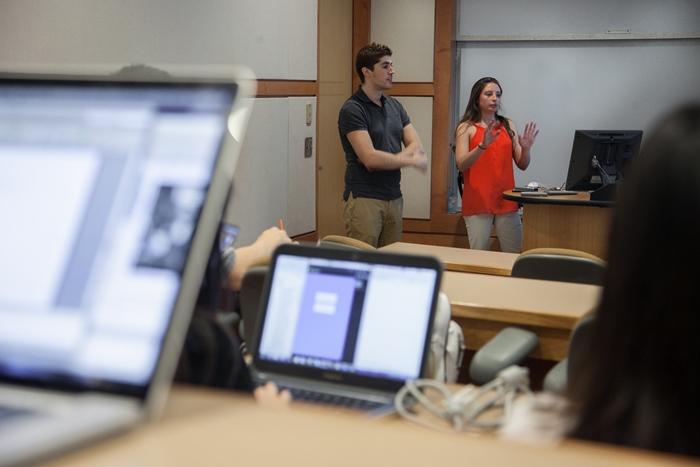Complexity on Display

Dan Appello and Danielle Erickson present their project, Multi-Cam Video Stitching: Panoramic Video Option During a Skype Call, to symposium attendees. Photo by Carl Socolow '77.
Senior seminar projects come to life at the Computer Science Symposium
by Tony Moore
The 2014 Computer Science Symposium was held in Tome Hall recently, and Tim Wahls, associate professor of computer science, summed up the significance of the gathering pretty well.
“Events like this are important,” he said, “because technical communication skills—the ability to convey detailed, complex information in a clear and concise way—are critical for all careers in computer science.”
And he wasn't kidding about the “complex” part. Take, for instance, the project created by Sam Kelly (philosophy, computer science), which he presented at an earlier honors defense: AST Indexing: A Near-Constant Time Solution to the Get-Descendants-by-Type Problem. But on the other side of the coin, Kelly shows just how ably students can explain these dense projects in understandable terms.
“I invented an algorithm that makes static analysis faster,” said Kelly, who noted that the algorithm is being integrated into the U.S. Department of Energy's ROSE compiler framework, the basis for Compass, an open-source project designed to detect security weaknesses in source code. “This means that important security vulnerabilities such as the now infamous Heartbleed bug can be detected significantly faster—although bug detection is just one type of static analysis, and my algorithm technically makes all static analysis faster.”
Other projects included Human Economic Behavior and Simulation Systems, by Min-Ji "Sophie" Huh (IB&M, economics, computer science); Mobile Data Collection iOS Application for Trees on Campus, by Chikako Kanamori (computer science); and A Hidden Markov Model Approach to Distinguishing Between Non-Prototypical Displays of Boredom and Interest, which Justine Heritage (mathematics, computer science) presented.
Through her project, Heritage studied a machine-learning approach to detecting emotion, specifically distinguishing between vocal expressions of boredom and interest. The research could be used to develop more sophisticated, intelligent online teaching and learning systems, and Heritage said that through her project, she also learned something about herself.
“I now have the ability to transfer the education I've gotten in computer science and math to completely new concepts without the help of a professor,” she said with surprise. “I often found myself thinking back to my freshman year, and I can't believe the extent to which my critical-thinking and problem-solving skills have developed since I first started.”
Heritage has set her sights on graduate school and eventually a career innovating computer-science programs in K-12 schools. Kelly will be conducting deep-learning artificial-intelligence research this summer for the U.S. Naval Research Laboratory in Washington, D.C., as part of Naval Research Enterprise Internship Program (NREIP). He’s also been accepted into Brown University’s master’s program in computer science.
“I was granted L-level (secret) security clearance for [the NREIP], which will definitely make it easier for me to get similar positions in the future,” he said. “All of that might not have been possible without my honors thesis.”
Learn more
- Department of Computer Science
- "Mining Data Gold"
- "Yeah, Science!"
- Students as Scholars
- Research presentations, listed by major
Published May 14, 2014